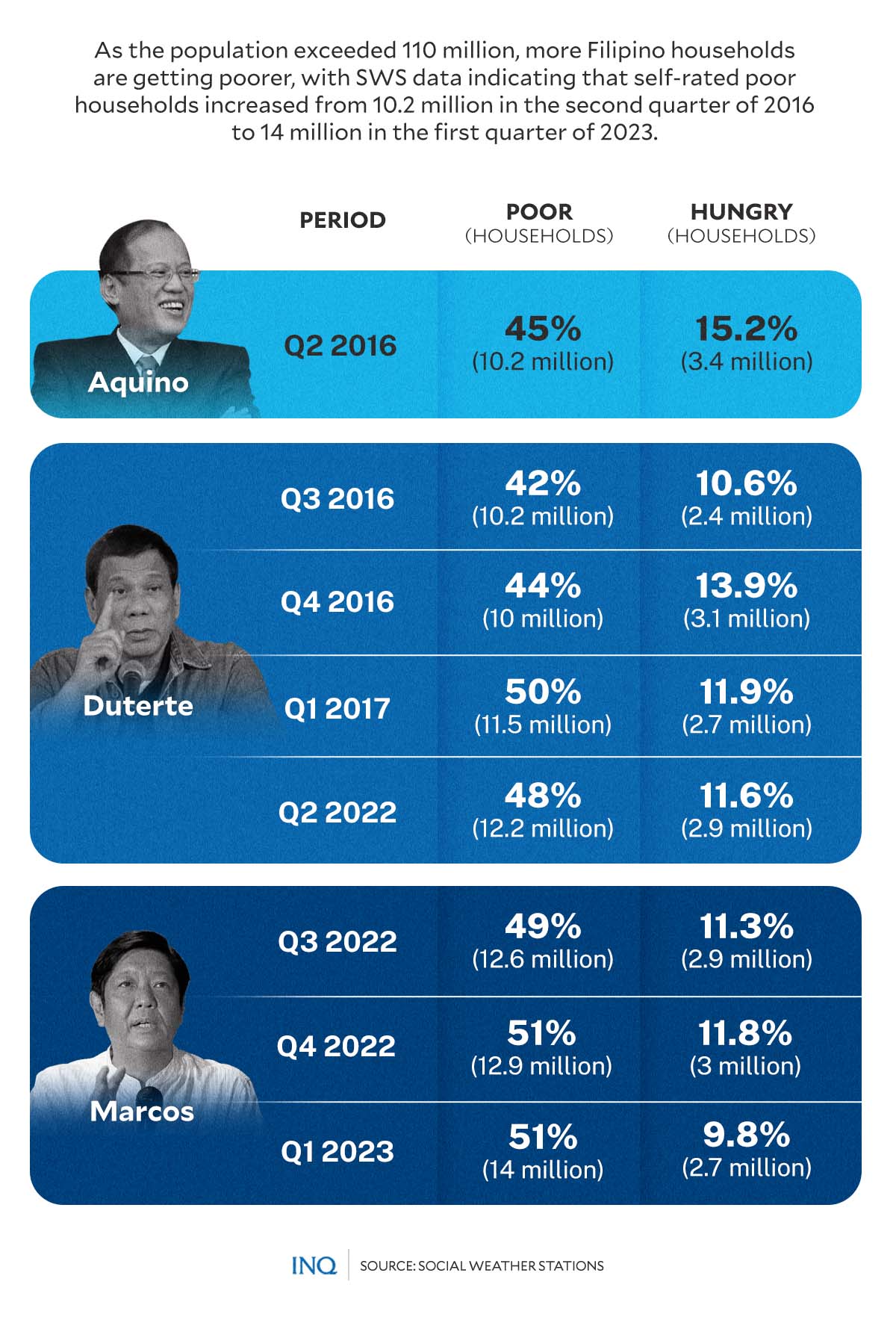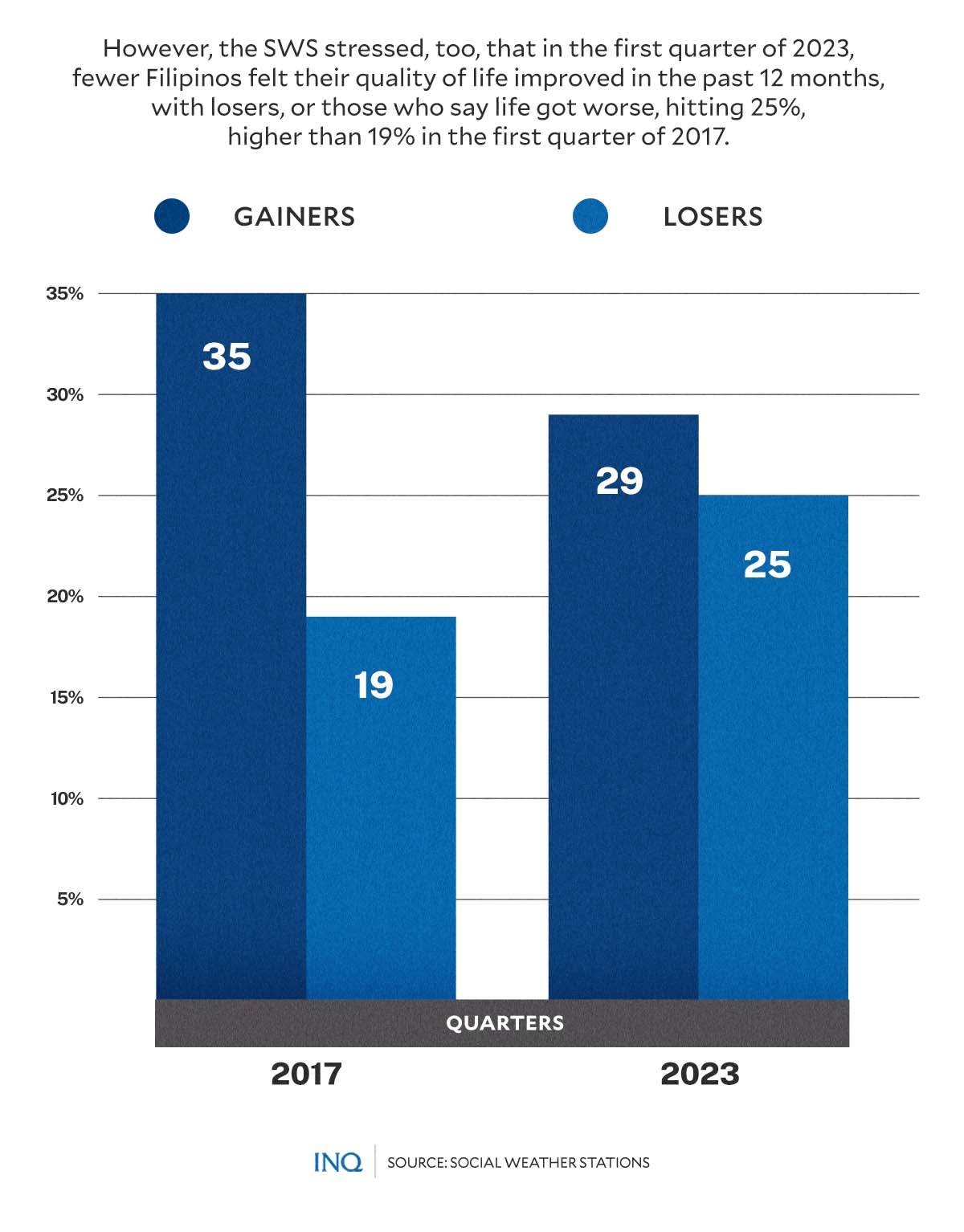1 year under Marcos presidency: Is economic recovery enough for a better life?
MANILA, Philippines—Last year, Ferdinand Marcos Jr., who was elected to the presidency with over 31 million votes, started his tenure with a promise of change that would benefit everyone.
It has been almost a year since Marcos was sworn into office at the National Museum Complex in Manila, where he stressed that he will not take his work lightly, and that he is “ready for the task.”
READ: Bongbong Marcos’ very first commitment as president: ‘I’ll get it done, no excuses from me’
Marcos, who won with a commanding lead, later promised at his first State of the Nation Address that he will end his six-year presidency with a better Philippines and a poverty rate of just 9 percent in 2028.
RELATED STORY: FULL TEXT: President Marcos’ 1st Sona
Article continues after this advertisementA year had passed, leaving five years for the Marcos presidency to “get it done,” but looking back at previous years it’s interesting to look at how life was, especially for millions of poor Filipinos still reeling from the standstill brought by the COVID-19 crisis.
Article continues after this advertisementEconomist Sonny Africa, executive director of the think tank Ibon Foundation, told INQUIRER.net via FB Messenger that “ordinary Filipinos have not had it good in the last year under the new administration.”
“The economy has reopened but millions of families remain distressed,” he said, pointing out that “the rebound just returned the economy to where it was three years ago before the pandemic.”
RELATED STORY: Marcos’ inaugural address: What was said, promised, left behind
This is the problem, Africa said, stressing that compared to 2019, the Philippines now has a larger population of over 110 million people “coping with post-lockdown scarring and denied a lifeline by misguided government austerity on social welfare.”
Poor, starving Filipinos
According to Social Weather Stations (SWS), there were 49 percent or 12.6 million households who considered themselves poor in the third quarter of 2022, the first three months of Marcos in Malacañang.
This rose to 51 percent in the last quarter of 2022 and in the first quarter of 2023, but SWS said the former only translated to 12.9 million households, while the latter translated to 14 million households.
READ: 14 million Filipino families consider themselves poor — SWS
Based on SWS data compiled by INQUIRER.net, the percentage of self-rated poor households increased by two percent, or 1.4 million from the third quarter of 2022 to this year’s first quarter.
The increase is lower than the 2.1 million that was seen in the first few months—third quarter of 2016 to first quarter of 2017—of Rodrigo Duterte, who was president from 2016 to 2022.
Unlike poverty, however, the first year of Marcos has seen a decrease in the percentage of Filipino households who are experiencing involuntary hunger, or being hungry and not having anything to eat.
Based on SWS data, Marcos started his presidency with an 11.3 percent hunger rate in the third quarter of 2022, which translates to 2.9 million households. This fell to 9.8 percent, or 2.7 million, in the first quarter of 2023.
Back in the first few months of Duterte, meanwhile, the percentage of households who experienced involuntary hunger was 10.6 percent, or 2.4 million, in the third quarter of 2016. This increased to 11.9 percent, or 2.7 million, in the first quarter of 2017.
SWS said the 9.8 percent hunger rate in the first quarter of 2023 consisted of 8.6 percent, or 2.3 million households, who experienced moderate hunger and 1.2 percent, or 340,000 households, who experienced severe hunger.
Resilient economy in the Marcos presidency
But according to Socioeconomic Planning Secretary Arsenio Balisacan at a meeting and business forum with Israeli officials and businessmen last June 6, “the economy [of the Philippines] remains resilient.”
He said the Philippine economy is “bouncing back quickly and growing robustly in 2022 with a record 7.6 percent annual growth rate and sustaining the return to the high growth rate path in the first quarter of this year with a growth rate of 6.4 percent.”
“The momentum remains strong,” said Balisacan, who pointed out slower inflation for four consecutive months, stressing that a coordinated and proactive monitoring system is in place to keep food and energy prices within the target range.
This, as the Philippine Statistics Authority (PSA) said inflation eased to 6.1 percent in May, down from 6.6 percent in April, bringing the year-to-date average inflation to 7.5 percent.
Likewise, Balisacan stated on June 9 that labor market conditions are improving.
Based on PSA data, the unemployment rate fell to 4.5 percent in April from 5.7 percent in the same month the previous year, indicating 506,000 individuals previously unemployed had found jobs.
The National Economic and Development Authority (Neda), which Balicasan also heads, also pointed out the drop in underemployment, saying that the rate is only 12.9 percent in April compared to 14 percent in the same month a year ago.
“To ensure the continuation of this trend, the government affirms its commitment to the unimpeded implementation of economic liberalization reforms and other essential legislation,” Balisacan said.
‘Deceptive’
Africa pointed out, though, that “economic growth is deceiving and only seems fast coming from such a low base because of the largest economic contraction in most of Asia.”
“The rebound is also over and gross domestic product (GDP) growth has been slowing since the fourth quarter of last year,” he said. Based on PSA data, the GDP posted a quarter-on-quarter growth of 1.1 percent in the first quarter of 2023.
Last year, GDP had a quarter-on-quarter growth of 1.72 percent in the first quarter, 0.1 percent in the second quarter, 3 percent in the third quarter, and 2.0 percent in the last quarter.
Africa said that “the government misleadingly hypes labor market conditions,” saying that the reported 1.5 million jobs created between June 2022 and April 2023 do not tell the whole story.
“Over this period, the number of full-time workers actually fell by 4.5 million while the number of part-time workers grew 5.5 million, aside from 369,000 more ‘with a job, not at work’,” he said.
Informal and low-paying work have increased, too.
Africa said Ibon Foundation estimated that the magnitude of jobs in self-employment, informal establishments, or other informal work has risen to around 35.1 million or 73 percent of the country’s total labor force.
Optimism declining in Marcos presidency
Based on latest SWS data, 29 percent of Filipinos said quality of life improved in the past 12 months, lower than the 34 percent in the last quarter of 2023. Some 25 percent said life worsened, while most, or 46 percent, said there was no change.
READ: SWS: Fewer Filipinos feel life quality improved last year
Compared to Duterte’s first few months, 29 percent is lower, too, than 35 percent in the first quarter of 2017. Likewise, there were fewer losers, or those saying that the quality of life got worse, at only 19 percent.
Inflation has accelerated since July 2022 at 6.4 percent and only started easing in March 2023 at 7.6 percent after hitting record highs of 8 percent and 8.1 percent in November and December 2022, 8.7 and 8.6 percent in January and February 2023.
The Marcos presidency increased the mandated minimum wage in Ilocos Region, Cagayan Valley, Central Luzon, Bicol Region, Eastern Visayas, Northern Mindanao, Davao Region, Soccsksargen, Cordillera Administrative Region and Caraga Region.
But Africa said the increase was only marginal at P10 to P30. “Yet the wage hikes have been so sparing that 10 regions have still seen the real or inflation-adjusted value of the minimum wage fall since June 2022,” he said.
Take as case the P570 Metro Manila minimum wage, which is the highest in the country. Inflation in the region has meant that this has already lost at least P29 of its value since June 2022.
“Accelerating inflation since last year has been reducing family spending and eroding family welfare,” Africa said.
He pointed out that household final consumption spending has been slowing for four consecutive quarters since the second quarter of 2022, from 10 percent growth in the first quarter of 2022 to 6.3 percent in the first quarter of 2023.
Based on SWS data, 45 percent of Filipinos said quality of life will improve in the next 12 months, while 42 percent said it will stay the same. Six percent, meanwhile, said it will worsen.
SWS said this resulted in a net personal optimism of +38, which is 6 points below +44 in the last quarter of 2022.
Earlier this year, the government released the Philippine Development Plan (PDP), which the government said envisions an economy that would be “beneficial for every Filipino.”
Neda stated that the PDP is a “plan for deep economic and social transformation […] by steering the economy back in a high-growth path.”
“This growth must be inclusive, building an environment that provides equal opportunities to all Filipinos, and equipping them with skills to participate fully in an innovative and globally competitive economy,” Neda said.
READ: Fewer Filipinos see improved quality of life in next 12 months under Marcos Jr. — SWS



